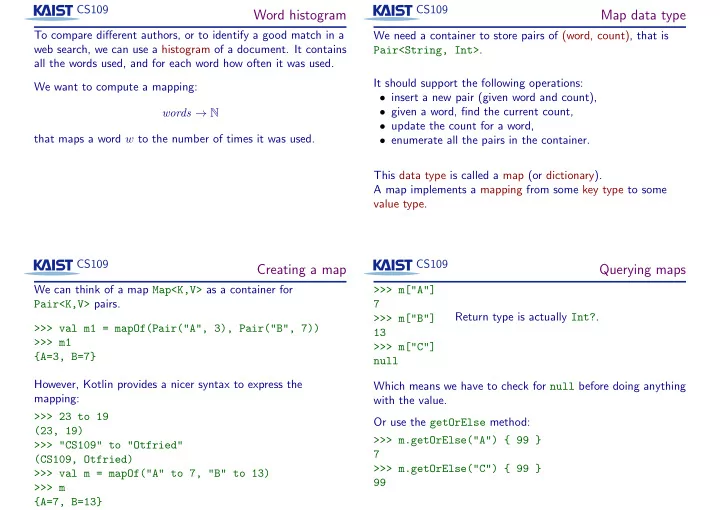

CS109 CS109 Word histogram Map data type To compare different authors, or to identify a good match in a We need a container to store pairs of (word, count), that is web search, we can use a histogram of a document. It contains Pair<String, Int> . all the words used, and for each word how often it was used. It should support the following operations: We want to compute a mapping: • insert a new pair (given word and count), • given a word, find the current count, words → N • update the count for a word, that maps a word w to the number of times it was used. • enumerate all the pairs in the container. This data type is called a map (or dictionary). A map implements a mapping from some key type to some value type. CS109 CS109 Creating a map Querying maps We can think of a map Map<K,V> as a container for >>> m["A"] Pair<K,V> pairs. 7 Return type is actually Int? . >>> m["B"] >>> val m1 = mapOf(Pair("A", 3), Pair("B", 7)) 13 >>> m1 >>> m["C"] {A=3, B=7} null However, Kotlin provides a nicer syntax to express the Which means we have to check for null before doing anything mapping: with the value. >>> 23 to 19 Or use the getOrElse method: (23, 19) >>> m.getOrElse("A") { 99 } >>> "CS109" to "Otfried" 7 (CS109, Otfried) >>> m.getOrElse("C") { 99 } >>> val m = mapOf("A" to 7, "B" to 13) 99 >>> m {A=7, B=13}
CS109 CS109 Map methods Looping over elements of the map Check if key is in map: We can use a for loop like for lists and arrays, but with two variables: >>> "A" in m >>> fun printMap(m: Map<String, Int>) { true >>> "C" in m ... for ( (k,v) in m) false ... println("$k --> $v") >>> "C" !in m ... } true >>> printMap(m) A --> 7 Size of the map and emptiness: B --> 13 >>> m.size 2 >>> m.isEmpty() false >>> m.isNotEmpty() true CS109 CS109 Mutable maps Word histogram We can also use mutable maps: fun histogram(fname: String): Map<String, Int> { val file = java.io.File(fname) >>> val m = mutableMapOf("A" to 7, "B" to 13) val hist = mutableMapOf<String, Int>() >>> println(m) file.forEachLine { {A=7, B=13} A useful method: getOrPut if (it != "") { >>> m["C"] = 99 >>> m.getOrPut("B") { 99 } val words = it.split(Regex("[ ,:;.?!<>()-]+")) >>> println(m) 42 for (word in words) { {A=7, B=13, C=99} >>> println(m) if (word == "") continue >>> m.remove("A") {B=42, C=99} val upword = word.toUpperCase() 7 >>> m.getOrPut("D") { 99 } hist[upword] = >>> println(m) 99 hist.getOrElse(upword) { 0 } + 1 {B=13, C=99} >>> println(m) } >>> m["B"] = 42 {B=42, C=99, D=99} } >>> println(m) } {B=42, C=99} return hist }
CS109 CS109 Printing the map Pronounciation dictionary Iterating over the pairs in a map: Let’s build a real “dictionary”, mapping English words to their pronounciation. for ((word, count) in h) println("%20s: %d".format(word, count)) We use data from cmudict.txt : ## Date: 9-7-94 Words show up in a rather random order. We can fix this by ## converting the map to a sorted map: ... val s = h.toSortedMap() ADHERES AH0 D HH IH1 R Z for ((word, count) in s) ADHERING AH0 D HH IH1 R IH0 NG println("%20s: %d".format(word, count)) ADHESIVE AE0 D HH IY1 S IH0 V ADHESIVE(2) AH0 D HH IY1 S IH0 V Maps are implemented using a hash table, which allows ... extremely fast insertion, removal, and search, but does not maintain any ordering on the keys. (Come to CS206 to learn about hash tables.) CS109 CS109 Reading the file Finding homophones Reading the dictionary file: English has many words that are homophones: they sound the fun readPronounciations(): Map<String,String> { same, like “be” and “bee”, or ”sewing” and ”sowing”. val file = java.io.File("cmudict.txt") Create a dictionary mapping pronounciations to words: var m = mutableMapOf<String, String>() fun reverseMap(m: Map<String, String>): file.forEachLine { Map<String, Set<String>> { l -> var r = mutableMapOf<String,MutableSet<String>>() if (l[0].isLetter()) { for ((word, pro) in m) { val p = l.trim().split(Regex("\\s+"), 2) val s = r.getOrElse(pro) { val word = p[0].toLowerCase() mutableSetOf<String>() } if (!("(" in word)) s.add(word) m[word] = p[1] r[pro] = s } } } return r return m } }
CS109 A word puzzle There are words in English that sound the same if you remove the first letter: ‘knight’ and ’night’ is an example. fun findWords() { val m = readPronounciations() for ((word, pro) in m) { val ord = word.substring(1) if (pro == m[ord]) println(word) } Is there a word where you can remove both the first or the second letter, and it will still sound the same?
Recommend
More recommend